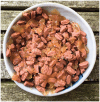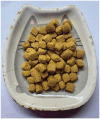Commercial vs Homemade Cat Diets: What you need to know
- PMID: 35311418
- PMCID: PMC11104037
- DOI: 10.1177/1098612X221090389
Commercial vs Homemade Cat Diets: What you need to know
Abstract
Practical relevance: A feeding plan recommendation for cats, both healthy and with disease, should include diet choice, amounts to feed and the feeding method. Diet choice can be complex owing to the abundance of products, sometimes with conflicting marketing messages, and the prevalence of information with no scientific basis. It is important to be aware of the specific challenges of both commercial and homemade diets. Moreover, a nutritional assessment is a prerequisite when recommending a diet to ensure that it is safe, appropriate for the cat's life stage and nutritious for long-term feeding.
Commercial vs homemade diets: There are a variety of commercial diets available, allowing considerable customisation. These products are regulated and can be tested to determine nutritional adequacy and safety, although as the industry is partly self-regulated, choice of manufacturer is important. Properly formulated homemade diets can be customised to the patient and are a good option when no commercial product that meets the patient's needs exists. Homemade diets can be an owner preference. A serious limitation is the lack of testing, potentially affecting safety and also resulting in a reliance on database information to determine nutritional adequacy. Generic homemade diet recipes (eg, sourced from the internet) have additional risks of deficiencies and imbalances, and are not recommended. Homemade diets should be devised by a veterinary nutrition specialist with consideration of both patient and owner factors.
Clinical challenges: Dietary misinformation, which is all too readily available on the internet, may result in owners making questionable feeding choices for their pets. A homemade diet may be requested by owners based on the perception that there are poor ingredients in commercial foods. The veterinary healthcare team needs to have good evidence-based information to present to owners about diet choice.
Evidence base: Several decades of research on feline nutrition forms the basis for nutritional requirements and dietary recommendations. There are varying degrees of evidence regarding requirements for each nutrient, and a lack of data on the effects of different types of processing on nutrient needs.
Keywords: Commercial cat food; cat food ingredients; cat food regulations; homemade diets; nutrition; nutritional deficiencies.
Conflict of interest statement
Cecilia Villaverde has carried out consultancy work for a variety of pet food companies. She has participated as an investigator in clinical trials sponsored by pet food companies. She develops educational materials for Mark Morris Institute. She is part of the Scientific Advisory Board of FEDIAF and a Co-Chair of the Global Nutrition Committee of the WSAVA. She participates as a speaker or attendee in continuing education events sponsored or organised by pet food companies.
Marge Chandler has received honoraria from pet food companies and previous research funding from pet food companies. She develops educational materials for the Mark Morris Institute. She is Chair of the Scientific Advisory Board of FEDIAF, Co-Chair of the Global Nutrition Committee of the WSAVA and a member of an advisory group for the Purina Institute.
Figures








References
-
- WSAVA Nutritional Assessment Guidelines Task Force Members: Freeman L, Becvarova I, Cave N, et al.. WSAVA nutritional assessment guidelines. J Small Anim Pract 2011; 52: 385-396. - PubMed
-
- National Research Council. Nutrient requirements of dogs and cats. The National Academies Press, Washington DC, 2006.
-
- Stable G. The domestic cat. London, George Routledge & Sons, 1876, p 61.
-
- Laflamme DP, Abood SK, Fascetti AJ, et al.. Pet feeding practices of dog and cat owners in the United States and Australia. J Am Vet Med Assoc 2008; 5: 687-694. - PubMed
-
- Michel JE, Willoughby KN, Abood SK, et al.. Attitudes of pet owners toward pet foods and feeding management of cats and dogs. J Am Vet Med Assoc 2008; 233: 1699-1703. - PubMed
MeSH terms
LinkOut - more resources
Full Text Sources
Miscellaneous

